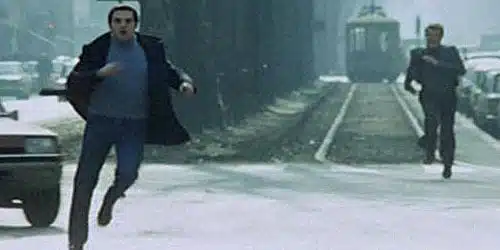
Italian director Paolo Cavara earned himself a place in cinema history for his influential 1962 “shockumentary” Mondo Cane, which spawned a whole genre of bizarro exploitation travelogues (often partially or wholly staged.) But as scandalous and original as Mondo Cane might have been, 1976’s Plot of Fear shows that Cavara was just as capable of producing forgettable, workmanlike procedurals as any other B-level director of the day.
Exhumed from obscurity by Raro Video and presented as an overlooked gem of gritty, psychosexual Italian sleaze, the truth behind the hyperbole is that Plot of Fear is little more than a mediocre, pedestrian example of an unremarkable poliziotteschi (a genre of Italian police thrillers popular in the ’70s). Although it features a handful of murders and plenty of naked flesh, it’s neither lurid enough to be enjoyed as camp, nor is it serious or believable enough to work as the gritty thriller it aspires to be. It’s basically devoid of the atmospheric direction or imaginative setpieces that usually draw genre fans to this sort of film, and the gorehounds and exploitation fans looking for untapped veins of ketchup-red giallo blood will find little worth remarking on, here.
The problems start with the title, which promises two things — a plot, and fear — both of which Cavara has more than a bit of trouble delivering. The plot (such as it is) is full of soap-opera-style twists and coincidences, and loosely revolves around a series of murders targeting the members of a sort of decadent sex-club for high-society elites (think Eyes Wide Shut with wider, louder ties) who also dabble in the smuggling of exotic animals and diamonds.
Michele Placido and his moustache play the main character, a police investigator halfheartedly attempting to unravel the case in between bouts of creepily racist pillow talk with his black supermodel girlfriend and casual sex with a mystery woman who lives in his apartment building (played by Corinne Cléry from 1975’s The Story of O.) Of course, it also just so happens that Cléry’s character was a witness to a murder at one of those high-society sex parties years earlier.
Does she know anything about the mysterious pages from a children’s picture book that the killer has been leaving as clues on each body, or the man with the mangled hand whom we see collecting newspaper clippings after each murder? Or why Tom Skerritt shows up for an inexplicable cameo as the “Chief Investigator”? (One imagines him taking an Italian vacation and stopping by the studio for an easy day of work in order to pay for it.)
No matter — this is the kind of movie where filmmakers add clues simply because they look interesting and then figure out explanations for them later. Cavara and his screenwriters seem to be going for Agatha Christie meets The French Connection, but the muddled result is more like Scooby Doo. The plot is filled with more red herrings than the Mediterranean, and by the time it arrives at the villain’s climactic speech detailing his absurdly-elaborate evil plan, the “solutions” to the film’s various mysteries are so lazy and perfunctory that one wonders how on earth it took three people to write such a trivial script. Why did the villain leave those cryptic illustrated clues that led the police right to him? It was simply a “challenge to the police… a macabre treasure hunt.” Why did he blackmail a team of assassins into doing his dirty work? Why, it was to prove a point that “anyone could become a murderer,” of course.
That being said, plot holes and bad acting can be forgiven, especially in a giallo, if the proceedings are at least fun or pulpy, but that’s not the case here. Aside from an utterly bizarre interlude of animated pornography inserted into one of the party scenes, Cavara plays it relatively straight – none of the wooden acting is sufficiently hammy enough to be enjoyable (not even the great Eli Wallach does any quality scenery-chewing in a sinister supporting role), and the various murder scenes are about as tame and unimaginative as any TV cop show from the ’70s.
Taken on its face, Plot of Fear is a screamingly mediocre piece of work, of dubious interest to even the most obsessed and completist fans of vintage giallo. For the rest of the world, there’s no reason to ever reach for something this bland over even the tamest efforts by Bava, Fulci, or Argento. To their credit, Raro Video provides a surprisingly generous package of extras that includes long interviews with co-writer Enrio Oldoini, lead actor Michele Placido, and Paolo Cavara’s son Pietro, plus an essay by Fangoria’s Chris Alexander. It’s just a shame that they have to discusses such a dull movie.

